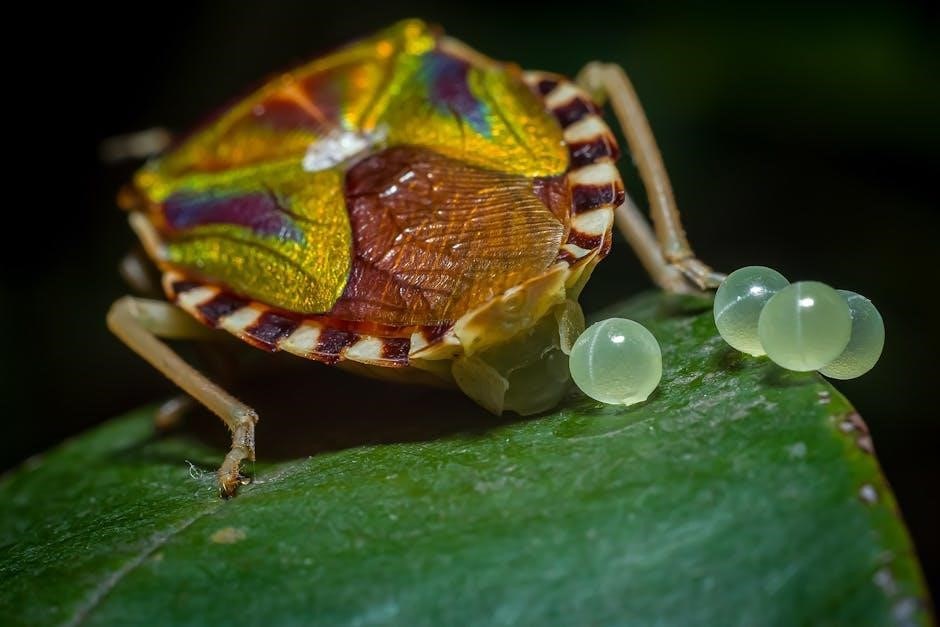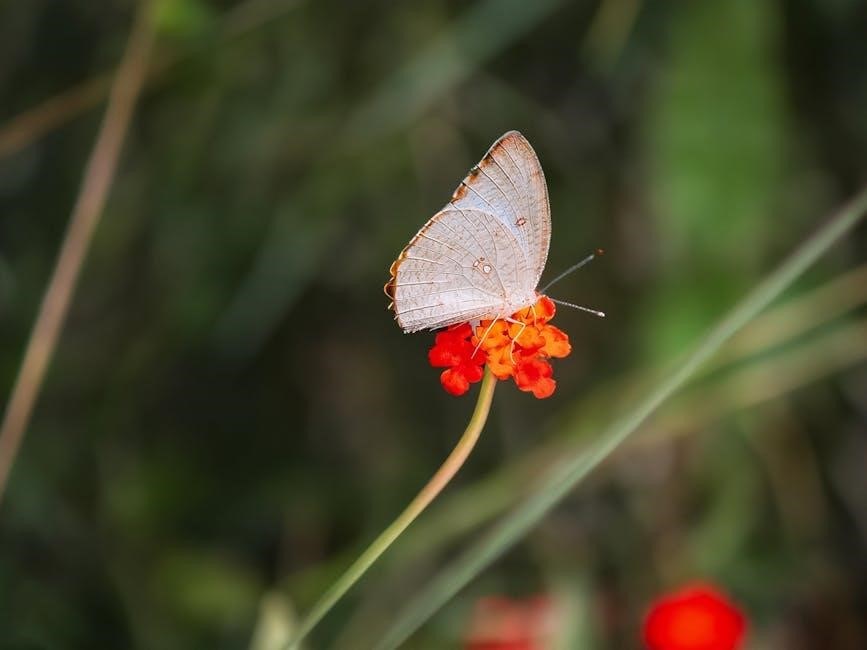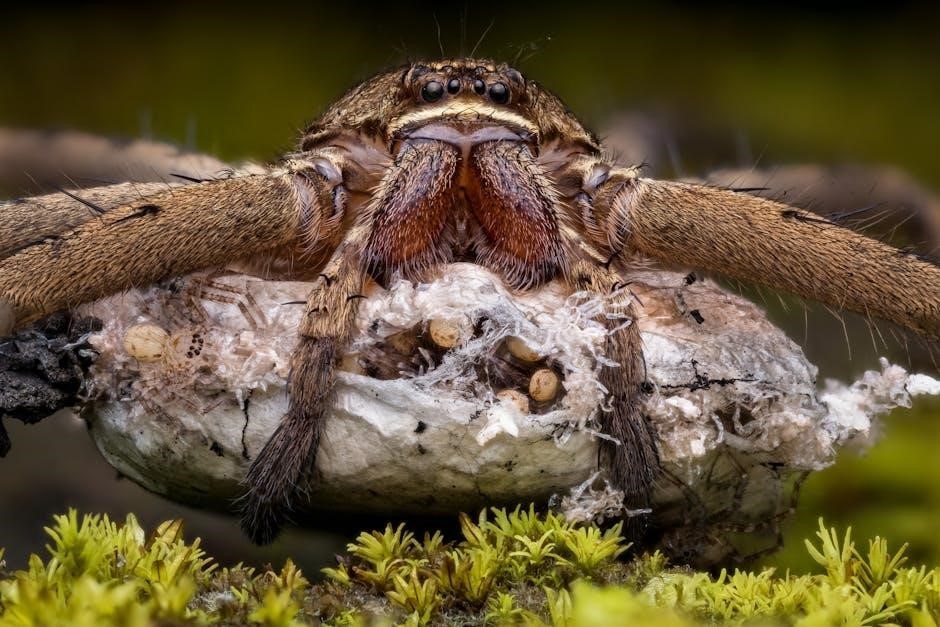Identifying insect eggs requires knowledge of shapes, sizes, and colors, using online guides and resources to determine types and prevent infestations, with a detailed guide available for gardeners and enthusiasts alike always․
Understanding the Importance of Insect Eggs Identification
Understanding the importance of insect eggs identification is crucial for effective pest management in gardens and agricultural fields․ Insect eggs can hatch into hungry larvae that can cause significant damage to plants, leading to reduced yields and economic losses․ By identifying insect eggs, gardeners and farmers can take proactive measures to prevent infestations and minimize damage․ This can be achieved by recognizing the shape, color, and location of insect eggs, as well as understanding the life cycles of different insect species․ Accurate identification of insect eggs can also help in determining the most effective control methods, reducing the need for pesticides and maintaining a balanced ecosystem․ Furthermore, insect eggs identification can also contribute to the development of integrated pest management strategies, which prioritize environmentally friendly and sustainable approaches to pest control․ Overall, understanding the importance of insect eggs identification is essential for maintaining healthy and productive gardens and agricultural fields․
Recognizing the Shape, Color, and Location of Insect Eggs
Insect eggs can be found in various shapes, colors, and locations, making recognition a crucial step in identification․ The shape of insect eggs can range from spherical to oval, while colors can vary from white to yellow, green, or even black․ Some insect eggs are laid on the surface of leaves or stems, while others are inserted into plant tissue or hidden in soil․ The location of insect eggs can also provide clues about the species, as some insects prefer specific plants or environments․ By observing the shape, color, and location of insect eggs, gardeners and naturalists can narrow down the possibilities and make a more informed identification․ A hand lens or microscope can be useful tools in examining the details of insect eggs, and online resources can provide reference images and descriptions to aid in recognition․ Accurate recognition of insect eggs is essential for effective identification and management․

How to Find Insect Eggs in the Garden
Examine plants and soil carefully to find insect eggs in gardens always using guides․
Observing Small Clusters or Individual Eggs on Plants or Soil
To identify insect eggs, it is essential to observe small clusters or individual eggs on plants or soil, as this can help determine the type of insect and potential infestation․
Using a magnifying glass or hand lens can aid in spotting these tiny eggs, which can be white, yellow, or brown in color․
Insect eggs can be found on leaves, stems, or soil, and may be laid in clusters or singly, depending on the species․
Careful observation of the eggs and their location can provide valuable clues for identification, such as the presence of a protective coating or distinctive shape․
By examining the eggs and their surroundings, gardeners and enthusiasts can gain a better understanding of the insects present in their garden and take steps to prevent infestations․
This information can be used to create a more effective pest management strategy, reducing the risk of damage to plants and minimizing the need for pesticides․
Observing insect eggs is an important step in maintaining a healthy and balanced garden ecosystem, and can be a fascinating and rewarding experience for nature enthusiasts․
Identifying Common Insect Eggs Found in Home Gardens
Identifying common insect eggs found in home gardens is crucial for effective pest management, as some insects can cause significant damage to plants․
Insect eggs can be found on various parts of plants, including leaves, stems, and flowers, and may be laid by different species, such as aphids, whiteflies, or beetles․
A thorough understanding of the types of eggs and their characteristics can help gardeners recognize potential problems and take action to prevent infestations․
Some common insect eggs found in home gardens include those of the cabbage moth, carrot rust fly, and onion fly, which can be identified by their distinctive shapes and colors․
By familiarizing themselves with these common insect eggs, gardeners can take proactive steps to protect their plants and maintain a healthy garden ecosystem․
This knowledge can also help gardeners make informed decisions about pest control methods and reduce their reliance on pesticides․
Effective identification of insect eggs is a key component of integrated pest management strategies, and can help gardeners maintain a balanced and thriving garden․

A Guide to Insect Egg Identification
Learning insect egg identification helps gardeners recognize potential problems, using online guides and resources to determine types and prevent infestations always effectively and efficiently every time and place․
Basic Insect Egg Identification Techniques
Basic insect egg identification techniques involve observing the eggs’ shape, size, color, and texture to determine the species of insect․ This can be done using a magnifying glass or a microscope to get a closer look․ Online resources and field guides can also be used to help identify the eggs․ It is important to note that insect eggs can be very small and may be difficult to see with the naked eye․ By using these techniques, gardeners and entomologists can identify the eggs and take steps to prevent infestations․ Additionally, understanding the life cycle of the insect can also help in identifying the eggs․ With practice and experience, anyone can become proficient in identifying insect eggs using these basic techniques․ Furthermore, being able to identify insect eggs can help in managing pest populations and preventing damage to plants․ This knowledge can be applied in various settings, including gardens, farms, and forests․
Using an Insect Egg Identification Chart
An insect egg identification chart is a valuable tool for identifying insect eggs, providing a visual guide to the different shapes, sizes, and colors of eggs․ These charts can be found online or in field guides and are often organized by type of insect or by the plant or location where the eggs are typically found․ By comparing the eggs found in the garden or yard to the images on the chart, it is possible to narrow down the options and make a positive identification․ The chart can also provide information on the life cycle of the insect and the potential damage it can cause, allowing for targeted pest management strategies․ Using an insect egg identification chart can be a fun and educational experience, and can help to develop a greater understanding of the natural world․ This can be especially useful for gardeners and naturalists․

Characteristics of Insect Eggs

Insect eggs have diverse shapes, sizes, and colors, with unique features for survival, using online guides to learn more about characteristics always helps gardeners and enthusiasts alike understand them better naturally․
Diverse Shapes, Sizes, and Colors of Insect Eggs
Insect eggs exhibit a wide range of shapes, sizes, and colors, making identification a challenging task․ The shape of an insect egg can be spherical, oval, or cylindrical, and sizes can vary from barely visible to several millimeters in length; Colors can also differ, with some eggs being white, yellow, or brown, while others may have distinctive patterns or markings․ Understanding these variations is crucial for accurate identification, as different species of insects can lay eggs with unique characteristics․ By studying the diverse shapes, sizes, and colors of insect eggs, gardeners and entomologists can gain valuable insights into the life cycles and behaviors of various insect species․ This knowledge can be used to develop effective pest management strategies and promote a healthier environment․ Online resources and guides can provide detailed information on the characteristics of insect eggs, helping individuals to improve their identification skills and make informed decisions․
Unique Features of Insect Eggs for Survival
Insect eggs have evolved unique features to ensure their survival, such as specialized textures, patterns, and colors that help them blend in with their surroundings․ Some eggs are covered in a sticky substance that prevents them from being washed away by rain or eaten by predators․ Others have a hard outer shell that protects them from damage, while some eggs are able to withstand extreme temperatures and moisture levels․ These adaptations enable insect eggs to survive in a wide range of environments, from the freezing tundra to the hottest deserts․ By studying these unique features, scientists can gain a better understanding of the complex relationships between insects and their environments․ This knowledge can also be used to develop new strategies for managing insect populations and preventing the spread of pests․ Online guides and resources can provide detailed information on the unique features of insect eggs, helping individuals to improve their understanding of these fascinating creatures․
